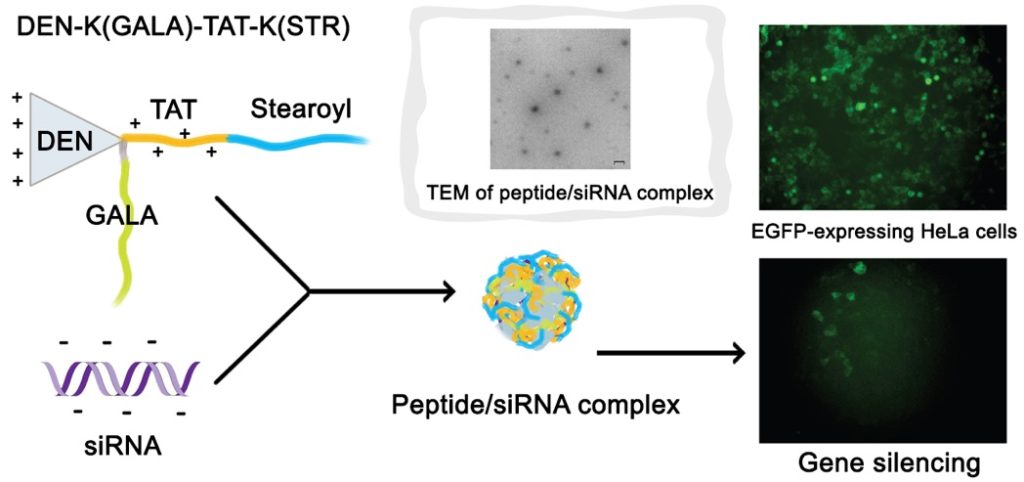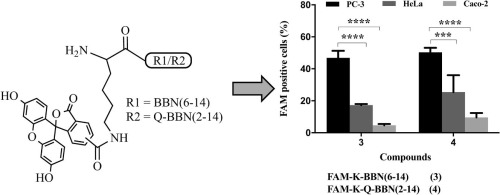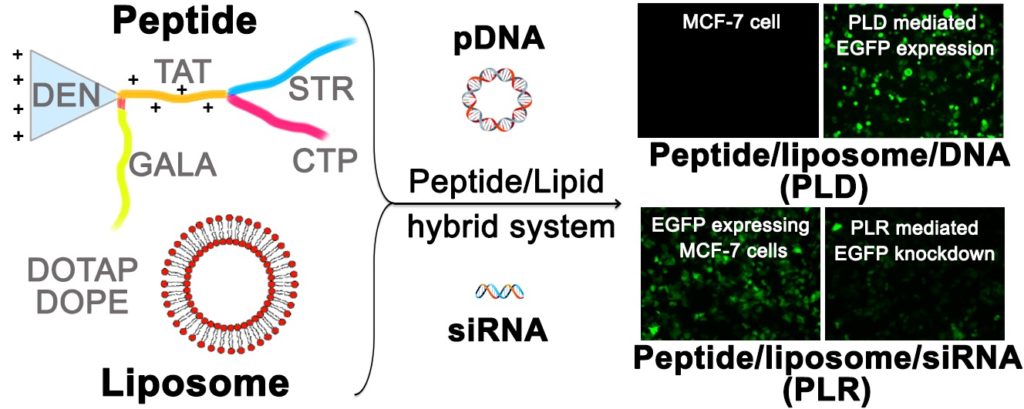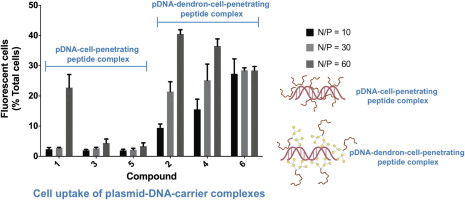5.1 Multifunctional Peptide-Lipid Nanocomplexes for Efficient Targeted Delivery of DNA and siRNA into Breast Cancer Cells
Type: Original Research
Citation: Wan Y, Dai W, Nevagi RJ, Toth I, Moyle PM. Multifunctional peptide-lipid nanocomplexes for efficient targeted delivery of DNA and siRNA into breast cancer cells. Acts Biomaterialia 2017;(In Press)
DOI: 10.1016/j.actbio.2017.06.032
Synopsis: The ability to target genes to cancers or to reduce the level of cancer associated genes is a new and exciting means to treat various tumours. In this paper, we have developed a efficient breast cancer targeted delivery system for both plasmid DNA and siRNA. This system contains many components, each designed to overcome barriers that face the delivery of genetic material such as cell uptake, oligonucleotide stability, escape from endosomes, and nuclear targeting. We demonstrate the capacity of this system to knockdown a cancer associated protein (Bcl-2), and the effect of this on cell proliferation. We believe that this system will prove to be an excellent means to deliver oligonucleotide material to breast cancer cells.
5.2 Design and Evaluation of a Stearylated Multicomponent Peptide-siRNA Nanocomplex for Efficient Cellular siRNA Delivery
Type: Original Research
Citation: Wan Y, Moyle PM, Gn PZ, Toth I. Design and evaluation of a stearylated multicomponent peptide-siRNA nanocomplex for efficient cellular siRNA delivery. Nanomedicine (Lond) 2017;12(4):281-93
Synopsis: This paper extends on our previous peptide-based multicomponent DNA delivery platform (Nanomedicine (Lond) 2016;11(8):907)) through the addition of stearic acid to the structure, in addition to the poly-L-lysine dendron, TAT(48-60) cell penetrating peptide, and GALA endosome escape peptide. The addition of stearic acid lead to significant improvements in cellular uptake, and was able to successfully deliver enhanced green fluorescent protein (eGFP; EGFP gene) siRNA into HeLa cells that stably over expressed eGFP, to successfully knockdown the expression of eGFP at both the mRNA and protein level. 
5.3 Investigation of Bombesin peptide as a targeting ligand for the gastrin releasing peptide (GRP) receptor
Type: Original Research
Citation: Begum AA, Moyle PM, Toth I. Investigation of Bombesin peptide as a targeting ligand for the gastrin releasing peptide (GRP) receptor. Bioorganic & Medicinal Chemistry 2016;(accepted manuscript)
DOI: 10.1016/j.bmc.2016.09.039
Synopsis: This paper focuses on characterising the bombesin (BBN) peptide, and a shorter analog (BBN(6-14)), as targeting moieties for the future delivery of oligonucleotide therapeutics. Using western blotting and flow cytometry, we measured the level of bombesin receptor (GRPR) and BBN peptide uptake in Caco-2, HeLa, LNCap, MDA-MB-231, and PC-3 cells. This work demonstrated that the uptake of BBN peptides is directly proportional to the amount of GRPR expressed in each cell line. Further, as there is a lack of information comparing the uptake of BBN peptides into different cell lines in the literature, this work will provide important information for the in vitro assessment of GRPR targeted therapeutics.

5.4 Peptide-based multicomponent oligonucleotide delivery systems: optimisation of poly-L-lysine dendrons for plasmid DNA delivery
Type: Original Research
Citation: Kamaruzaman KA, Moyle PM, Toth I. Peptide-based multicomponent oligonucleotide delivery systems: optimisation of poly-L-lysine dendrons for plasmid DNA delivery. International Journal of Peptide Research and Therapeutics 2016;(accepted manuscript)
DOI: 10.1007/s10989-016-9545-5
Synopsis: This paper focuses on optimising the toxicity, cellular uptake, and condensation of pDNA using synthetic poly-L-lysine (PLL) dendrons, fused to the cell penetrating peptide TAT(48-60). A library of PLL dendrons with charges between 4+ and 16+ were synthesised. In addition, hexahistidine was investigated for its potential to improve the endosome escape of these systems. This work concluded that increasing the charge of the PLL dendron improved cellular uptake and pDNA condensation, without any effect on cellular toxicity. In addition, PLL dendrons greater than 16+ charge could not be efficiently synthesised, and the addition of hexahistidine in general generated larger sized complexes with pDNA, with detrimental effects on cellular uptake.
5.5 Nanosized, peptide-based multicomponent DNA delivery systems: optimization of endosome escape activity
Type: Original Research
Citation: Yu W, Moyle PM, Christie MP, Toth I. Nanosized, peptide-based multicomponent DNA delivery systems: optimization of endosome escape activity. Nanomedicine (Lond.) 2016;11(8):907-19
DOI: 10.2217/nnm.16.27
Synopsis: Three endosome-disrupting peptides [HA2(1-20), GALA, and KALA) were incorporated into our branched, multicomponent oligonucleotide delivery platform in order to identify which peptide imparted the most favourable endosome escape and toxicity profile. To achieve the simple and efficient incorporation of these peptides into our delivery system, we developed a Copper(I)-catalyzed azide-alkyne cycloaddition (CuAAC) process to enable the rapid production of our delivery system library. Each system could condense plasmid DNA to form nanosized particles. The highest cellular uptake was observed for those systems incorporating KALA or GALA. However, KALA was associated with significantly greater toxicity. Overall, we selected GALA as the most efficient and least toxic fusogenic endosome escape peptide for incorporation into our multicomponent, peptide-based oligonucleotide delivery platform.
5.6 Endosome escape strategies for improving the efficacy of oligonucleotide delivery systems
Type: Review
Citation: Wan Y, Moyle PM, Toth I. Endosome Escape Strategies for Improving the Efficacy of Oligonucleotide Delivery Systems. Current Medicinal Chemistry 2015;22(29):3326-46
DOI: 10.2174/0929867322666150825162941
Synopsis: Gene therapy requires safe and effective vectors to deliver genes to their target site of action. Non-viral gene delivery systems have attracted growing attention due to their low toxicity, low immunogenicity and ease of production compared to viral vectors. Most non-viral gene delivery systems enter cells via endocytic pathways, and their escape from endosomes is therefore crucial for successful transfection. Several reagents have been developed to promote endosomal escape, including peptides, polymers and lipids. Among these, endosome-disrupting peptides have been used in many studies, and have proven to be one of the most promising approaches to overcome endosomal entrapment and lysosomal degradation. This review provides an up-to-date summary of strategies for enhancing endosomal escape, with a focus on the modification of endosome-disrupting peptides to further increase the efficient delivery of oligonucleotides.
5.7 Peptide based DNA nanocarriers incorporating a cell-penetrating peptide derived from neurturin protein and poly-L-lysine dendrons
Type: Original Research
Citation: Rosli N, Christie MP, Moyle PM, Toth I. Peptide based DNA nanocarriers incorporating a cell-penetrating peptide derived from neurturin protein and poly-L-lysine dendrons. Bioorganic & Medicinal Chemistry 2015;23(10);2470-9
DOI: 10.1016/j.bmc.2015.03.058
Synopsis: Multicomponent gene delivery systems incorporating cell-penetrating peptides (CPP) from the human neurturin protein (NRTN-30, NRTN(132-161); NRTN-17, NRTN(145-161)) and a poly-l-lysine (PLL) dendron, were synthesized and characterized for plasmid DNA (pDNA) delivery. Acetylated NRTN peptides (Ac-CPP) and peptides conjugated to a PLL dendron (DEN-CPP) efficiently condensed and stabilized pDNA. Complexes between pDNA and DEN-CPP formed smaller and more stable nanoparticles. Flow cytometry experiments showed that pDNA–DEN-CPPs were taken up more efficiently into HeLa cells. There was also no significant difference between NRTN-30 and NRTN-17 for pDNA uptake, indicating that the truncated peptide alone is sufficient as a CPP for pDNA delivery.

